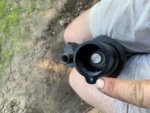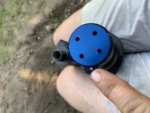This is primarily an informational post on what I have done to correct a leak on a Volvo Penta Steering Ram.
I have attached a picture of my type of steering ram (not my actual one) for reference.
Mine has part number 3862210 on it -- I understand there are many others that are similar. A newer part number for mine is 3862513. This ram was on a 2003 Four WInns 240H -- 5.7Gi--- The stern drive is part 3868913 -- Type DP-SM

The hydraulic cylinder was leaking at the end of the cylinder rod and would leak so much that it would pump a full bottle of fluid in the bilge in an hour or so.
I read all over the internet -- including searches here, and found "they are not rebuildable" but "someone has done it somewhere".
I decided since it was of no value as it is -- why not take it apart and see if it could be repaired.
On the end of the bottom cylinder is a cap that has four deep holes in it (left side of photo above -blue). I make a spanner from a piece of wood with four nails in it at the same spacing (nails were cut flat on the end) and this opened the end piece easily. The piston will now slide out of that end (assuming you have unthreaded the piece on the other end). When I looked inside the rod end where the leak was, I could see the reason for the leak.. On that end is first the wiper seal, and then the piston seal. The piston sealed had probably hardened and then cracked. There was no way that a simple power steering "stop leak" === which I had tried anyway, was going to work at all.
I removed the wiper seal in reusable condition by carefully prying from under it.
I then removed the totally worn out rod seal. It came out in many small hard pieces.
I took all this to a local hydraulic shop.
In this case it was "Hydraulic Supply Co." here in West Palm Beach Florida. They of course had not seen anything like the steering ram and had no direct experience with it. They did however, accurately measure the location of the piston seal and provided me with an alternative saying "give this a try".
They used Piston Seal --- Poly-Pack --- U12-0.62-SQB and
Hercules Urethane Backup --- 575-208.
They gave me the unit back with the seals in place so I did not see them install the seals.
The total cost of both pieces was $4.93 including tax.
I reassembled everything -- using the old wiper seal (they did not have on hand any they thought would be better than what I had, and reinstalled the steering ram.
It bled easily and now turns better and quieter than it has for a while.
I have tested the unit at my house about three times now, and it does not have any leaks.
I plan to water test it and take the boat out within the next week.
For reference the removal and installation while the engine is in the way is not an easy task. I removed my starboard riser to help gain access and it still took quite a few hours to get all the cotter pins out and such. Since I boat in salt water parts are always stuck which should come apart easily.
I will update this in the next few weeks, and then in a month or so, as a followup to let you know how it survives over at least that time.
Like any advice that comes on any site -- You do this at your own risk. Be careful in that you are dealing with 1000-1300PSI of hydraulic pressure. If you are a reasonably competent mechanical person you could accomplish this.
I have attached a picture of my type of steering ram (not my actual one) for reference.
Mine has part number 3862210 on it -- I understand there are many others that are similar. A newer part number for mine is 3862513. This ram was on a 2003 Four WInns 240H -- 5.7Gi--- The stern drive is part 3868913 -- Type DP-SM

The hydraulic cylinder was leaking at the end of the cylinder rod and would leak so much that it would pump a full bottle of fluid in the bilge in an hour or so.
I read all over the internet -- including searches here, and found "they are not rebuildable" but "someone has done it somewhere".
I decided since it was of no value as it is -- why not take it apart and see if it could be repaired.
On the end of the bottom cylinder is a cap that has four deep holes in it (left side of photo above -blue). I make a spanner from a piece of wood with four nails in it at the same spacing (nails were cut flat on the end) and this opened the end piece easily. The piston will now slide out of that end (assuming you have unthreaded the piece on the other end). When I looked inside the rod end where the leak was, I could see the reason for the leak.. On that end is first the wiper seal, and then the piston seal. The piston sealed had probably hardened and then cracked. There was no way that a simple power steering "stop leak" === which I had tried anyway, was going to work at all.
I removed the wiper seal in reusable condition by carefully prying from under it.
I then removed the totally worn out rod seal. It came out in many small hard pieces.
I took all this to a local hydraulic shop.
In this case it was "Hydraulic Supply Co." here in West Palm Beach Florida. They of course had not seen anything like the steering ram and had no direct experience with it. They did however, accurately measure the location of the piston seal and provided me with an alternative saying "give this a try".
They used Piston Seal --- Poly-Pack --- U12-0.62-SQB and
Hercules Urethane Backup --- 575-208.
They gave me the unit back with the seals in place so I did not see them install the seals.
The total cost of both pieces was $4.93 including tax.
I reassembled everything -- using the old wiper seal (they did not have on hand any they thought would be better than what I had, and reinstalled the steering ram.
It bled easily and now turns better and quieter than it has for a while.
I have tested the unit at my house about three times now, and it does not have any leaks.
I plan to water test it and take the boat out within the next week.
For reference the removal and installation while the engine is in the way is not an easy task. I removed my starboard riser to help gain access and it still took quite a few hours to get all the cotter pins out and such. Since I boat in salt water parts are always stuck which should come apart easily.
I will update this in the next few weeks, and then in a month or so, as a followup to let you know how it survives over at least that time.
Like any advice that comes on any site -- You do this at your own risk. Be careful in that you are dealing with 1000-1300PSI of hydraulic pressure. If you are a reasonably competent mechanical person you could accomplish this.





















